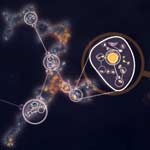
Networks—both real and virtual—are everywhere, from our social media circles to the power grid that delivers electricity. The interactions of genes, proteins and other molecules in a cell are examples of networks, too.
Scientists working in a field called systems biology study and chart living networks to learn how the individual parts work together to make a functioning whole and what happens when these complex, dynamic systems go awry. For example, the network diagram here depicts yeast cells (superimposed circles) and the biochemical “chatter” between them (lines) that tells the cells to gather together in clumps. This clumping helps them survive stressful conditions like a shortage of nutrients.
Network diagrams provide more than just hub-and-spoke pictures. They can yield information that helps us better understand—and potentially influence—complex phenomena that affect our health.
Read more about network analysis and systems biology in this Inside Life Science article.


To your knowledge, does total blindness in humas affect the biological clock and circadian rythms?